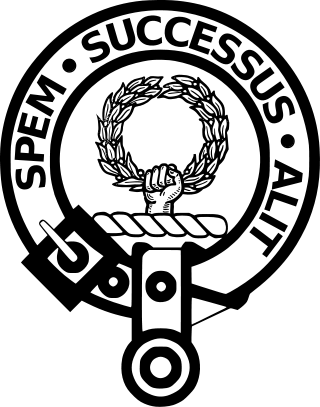
Clan Ross is a Highland Scottish clan. The original chiefs of the clan were the original Earls of Ross.

Clan Mackenzie is a Scottish clan, traditionally associated with Kintail and lands in Ross-shire in the Scottish Highlands. Traditional genealogies trace the ancestors of the Mackenzie chiefs to the 12th century. However, the earliest Mackenzie chief recorded by contemporary evidence is Alexander Mackenzie of Kintail who died some time after 1471. Traditionally, during the Wars of Scottish Independence, the Mackenzies supported Robert the Bruce, but feuded with the Earls of Ross in the latter part of the 14th century.

Clan Fraser of Lovat is a Highland Scottish clan and the principal branch of Clan Fraser. The Frasers of Lovat are strongly associated with Inverness and the surrounding area since the Clan's founder gained lands there in the 13th century.

Clan Graham has two main families of Scottish clans, the Grahams of Menteith and the Grahams of Montrose. Each have their own tartan patterns. William Graham became the 7th Earl of Menteith in 1610 in what is now Perthshire, Scotland. The Grahams of Montrose had territories in both the Scottish Highlands and Lowlands, and the chief of the clan rose to become the Marquess and later Duke of Montrose.
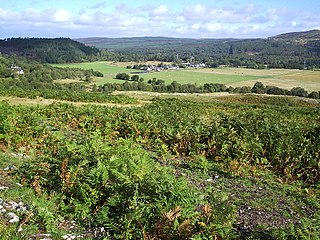
The Battle of Carbisdale took place close to the village of Culrain, Sutherland, Scotland on 27 April 1650 and was part of the Wars of the Three Kingdoms. It was fought by the Royalist leader James Graham, 1st Marquess of Montrose, against the Scottish Government of the time, dominated by Archibald Campbell, 1st Marquess of Argyll and a grouping of radical Covenanters, known as the Kirk Party. The Covenanters decisively defeated the Royalists. The battlefield has been inventoried and protected by Historic Scotland under the Scottish Historical Environment Policy of 2009. Although Carbisdale is the name of the nearest farm to the site of the battle, Culrain is the nearest village.

Chanonry Castle, also known as Seaforth Castle, was located in the town of Fortrose, to the north-east of Inverness, on the peninsula known as the Black Isle, Highland, Scotland. Nothing now remains of the castle.

The Battle of Bealach nam Broig was fought between Scottish clans from the lands of north-west Ross, against north-eastern clans of Ross who supported the Earl of Ross. The actual date of the battle is debated, it probably occurred in 1452 but the Conflicts of the Clans suggests a date as early as 1299.

The Battle of Logiebride or Logie-Riach, also known as a Tumult in Ross was more of a small skirmish rather than an actual battle. The disturbance is said to have taken place on 4 February 1597 at the Logie Candlemas market near Conan House between men of the Clan Mackenzie against men of the Clan Munro and the Bain family of Tulloch Castle.
Robert Mor Munro, 15th Baron of Foulis, and 18th chief of the Clan Munro was a 16th-century Scottish chief. He was known as Robert Mor on account of his large stature. He was the eldest son of Robert Munro, 14th Baron of Foulis. Although this Robert Munro is traditionally 15th Baron and 18th overall chief of the clan, he is only the 8th Munro chief that can be proved by contemporary evidence.

George Mackenzie, 2nd Earl of Seaforth was a Highland clan chief and Scottish nobleman, who played an equivocating role in Scotland in the Wars of the Three Kingdoms.
Sir Hector Munro, 2nd Baronet of Foulis was a Scottish noble and clan chief of the highland Clan Munro. He is also by tradition the 20th Baron and 23rd overall chief of the clan. However, he is actually the 13th chief of the Clan Munro who can be proved by contemporary evidence.

Clan Munro is a Highland Scottish clan. Historically the clan was based in Easter Ross in the Scottish Highlands. Traditional origins of the clan give its founder as Donald Munro who came from the north of Ireland and settled in Scotland in the eleventh century, though its true founder may have lived much later. It is also a strong tradition that the Munro chiefs supported Robert the Bruce during the Wars of Scottish Independence. The first proven clan chief on record however is Robert de Munro who died in 1369; his father is mentioned but not named in a number of charters. The clan chiefs originally held land principally at Findon on the Black Isle but exchanged it in 1350 for Estirfowlys. Robert's son Hugh who died in 1425 was the first of the family to be styled "of Foulis", despite which clan genealogies describe him as 9th baron.
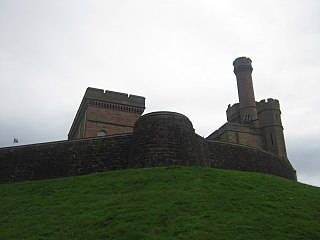
The siege of Inverness that took place in November 1715 was part of the Jacobite rising of 1715. The town of Inverness and Inverness Castle were being held by the Clan Mackenzie, led by Sir John Mackenzie of Coul who supported the rebel Jacobite cause. Simon Fraser, 11th Lord Lovat, chief of the Clan Fraser of Lovat besieged them, supported by men of the Clan Rose and Clan Forbes.

The Skirmish of Alness was a conflict that took place in October 1715 in Alness, in the county of Ross in the Scottish Highlands. It was part of the Jacobite rising of 1715 and pitted Highlanders loyal to the British-Hanoverian Government of George I of Great Britain against Highlanders loyal to the Jacobite House of Stuart.

The siege of Brahan took place in Scotland in November 1715 and was part of the Jacobite rising of 1715. Highlanders loyal to the British-Hanoverian government of George I of Great Britain laid siege to Brahan Castle, seat of William Mackenzie, 5th Earl of Seaforth, who was a staunch Jacobite, loyal to the House of Stuart.
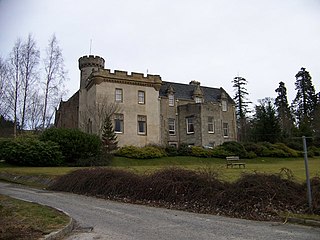
The Bain, Bane or Bayne family of Tulloch were a minor Scottish noble family.
John Munro, 2nd of Lemlair was a Scottish soldier who fought as a colonel in the Wars of the Three Kingdoms. His seat was at Lemlair House.
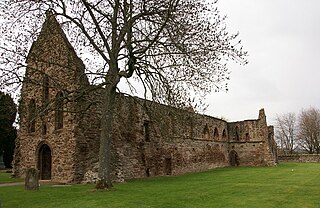
The dispute over the lands of Beauly Priory took place in about 1577-78 in Beauly, Inverness-shire, Scottish Highlands. It was contested between Colin Cam Mackenzie, 11th of Kintail, chief of Clan Mackenzie and Thomas Fraser of Knockie who was the tutor to the young Simon Fraser, 6th Lord Lovat, chief of the Clan Fraser of Lovat. Fraser was supported by Robert Mor Munro, 15th Baron of Foulis.
Thomas Mackenzie of Pluscarden, also known as of Pluscardine was a Scottish soldier and member of parliament of the 17th century. He was a member of the Clan Mackenzie, a Scottish clan of the Scottish Highlands.

The Mackenzies of Gairloch were a minor noble Scottish family and one of the senior cadet branches of the Clan Mackenzie, a Scottish clan of the Scottish Highlands.
















